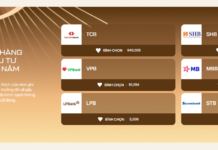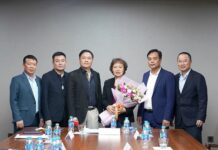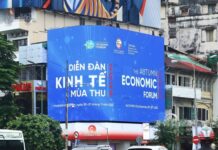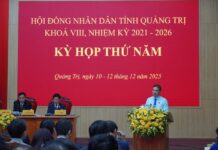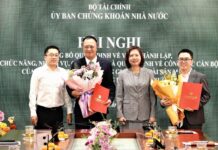
The National Assembly Standing Committee has issued Resolution No. 1191/NQ-UBTVQH15, approving the adjustment of administrative units in Bac Giang City, Bac Giang Province.
Per the resolution, the entire natural area of Yen Dung District, measuring 191.74 square kilometers, and its entire population of 176,980 people, will be merged into Bac Giang City. Following this merger, Bac Giang City will encompass a natural area of 258.29 square kilometers and a population of 371,151 individuals.
Additionally, the resolution approves the merger of Tran Nguyen Han Ward into Ngo Quyen Ward, and the merger of Le Loi Ward into Tran Phu Ward. Furthermore, Tan An Ward will be established by merging Lao Ho Commune and Tan An Town.
Twelve other wards will be established by merging communes, retaining their original names: Dinh Tri, Tan Tien, Tan My, Song Mai, Dong Son, Song Khe, Nham Bien, Tan Lieu, Noi Hoang, Tien Phong, Cang Thuy, and Huong Gian.

Following these adjustments, Bac Giang City will comprise 31 communal-level administrative units, including 21 wards: Cang Thuy, Dinh Ke, Dinh Tri, Da Mai, Dong Son, Hoang Van Thu, Huong Gian, My Do, Ngo Quyen, Nham Bien, Noi Hoang, Song Khe, Song Mai, Tan An, Tan My, Tan Tien, Tan Lieu, Tho Xuong, Tien Phong, Tran Phu, Xuong Giang, and 10 communes: Dong Phuc, Dong Viet, Duc Giang, Lang Son, Quynh Son, Tien Dung, Tri Yen, Tu Mai, Xuan Phu, and Yen Lu.
Concurrently, the People’s Court and the Procuracy of Yen Dung District will be dissolved. The People’s Court and the Procuracy of Bac Giang City, Bac Giang Province, will assume the tasks and powers of the People’s Court and the Procuracy of Yen Dung District as stipulated by law.
This resolution will take effect on January 1, 2025.

Bac Giang City is the capital of Bac Giang Province and is located approximately 60 kilometers from Hanoi.
In July 2024, Deputy Prime Minister Tran Hong Ha signed Decision No. 728/QD-TTg, recognizing Bac Giang as a Grade-2 urban area directly under Bac Giang Province. This decision was based on the entire existing administrative boundaries of Bac Giang City and Yen Dung District, covering an area of 258.30 square kilometers and comprising 34 communal-level administrative units.
The inner-city area is expected to encompass 16 communal-level administrative units of Bac Giang City, including 10 existing wards and six anticipated wards formed from the following communes: Dinh Tri, Tan My, Dong Son, Tan Tien, Song Mai, and Song Khe. Additionally, eight communal-level administrative units of Yen Dung District are included: Nham Bien Town, the anticipated merger of Tan An Town and Lao Ho Commune, and the communes of Noi Hoang, Tien Phong, Tan Lieu, Huong Gian, and Cang Thuy.
The attainment of Grade-2 urban status by Bac Giang (including Yen Dung District and Bac Giang City) is a significant step, enabling the locality to leverage its advantages, attract investment, foster socio-economic development, and continue the process of administrative unit reorganization and merger.
Bac Giang Province Aims for 22 Urban Areas
In May 2024, the Provincial People’s Council of Bac Giang issued Resolution No. 10/NQ-HĐND, approving adjustments to the provincial planning for the period 2021-2030, with a vision towards 2050.
The resolution adjusts the areas within the province’s key economic region to align with the plan for administrative unit reorganization. This region now includes Bac Giang City (following its merger with Yen Dung District), Viet Yen Town, Hiep Hoa District, the western and southwestern areas of Luc Nam District (comprising Doi Ngo Town and nine communes: Phuong Son, Chu Dien, Lan Mau, Yen Son, Kham Lang, Bac Lung, Vu Xa, Cam Ly, and Dan Hoi), and a portion of Lang Giang District’s southern area (comprising Voi Town and six communes: Xuan Huong, Tan Dinh, Thai Dao, Dai Lam, My Thai, and Xuong Lam).
Regarding the development of county-level regions, the planning for the Yen Dung and Luc Ngan regions has been removed to align with the plan for administrative unit reorganization, which involves the merger of Yen Dung District into Bac Giang City and the division of Luc Ngan District into the new Chũ Town and Luc Ngan District.
The resolution also adjusts the development plan for the Bac Giang City region and renames the development plan for the Viet Yen region to reflect its new status as Viet Yen Town. Additionally, it introduces development plans for the Chũ Town region and the new Luc Ngan District region.

By 2030, Bac Giang Province aims to have 22 urban areas (a reduction of seven urban areas compared to the previously approved plan). These will include one Grade-1 urban area (Bac Giang City), one Grade-3 urban area (Viet Yen City), four Grade-4 urban areas, and 16 Grade-5 urban areas.
From 2023 to 2025, Bac Giang Province plans to reorganize four administrative units at the district level (including one urban district, Bac Giang City) into four new administrative units at the district level (including two new urban districts). Specifically, the entire Yen Dung District will be merged into Bac Giang City, and Luc Ngan District and Son Dong District will be reorganized to form the new Chũ Town, Luc Ngan District, and Son Dong District.
During this period, the province also plans to reorganize five administrative units at the commune level that are classified as urban areas, including three units that fall under the mandatory reorganization category and two units that are encouraged to reorganize.
Additionally, 13 communes are expected to be converted into wards and towns. From 2026 to 2030, the province plans to reorganize three administrative units at the commune level that are classified as urban areas.
The First Target of N.H.O’s Transformation Journey Since 2024
The dynamic growth of Hai Phong in recent years has captured the attention of domestic and foreign investors alike. This vibrant city is rapidly emerging as a lucrative investment destination, offering a plethora of opportunities across various sectors. With its strategic location, robust infrastructure, and a thriving economy, Hai Phong presents an attractive prospect for businesses seeking expansion or new ventures. The city’s ongoing transformation and potential for sustainable development make it a prominent player in Vietnam’s economic landscape, paving the way for exciting possibilities and a prosperous future.
The Brilliant City of Light: A Vision for Nghe An
To embark on a journey towards sustainable urban development, Nghe An will be crafting focused programs, projects, and research initiatives. As a key initiative, the province will pilot the ‘City of Lights’ project in Vinh City during the phase of 2024-2025, illuminating a path towards a brighter and more prosperous future.
The High-Speed Rail Network’s Urban Revolution: A City for Every Stop.
“The proposed high-speed North-South railway line is an ambitious and unprecedented infrastructure project in Vietnam’s public investment history, with an estimated total cost of nearly $70 billion. According to Deputy Minister of Planning and Investment, Tran Quoc Phuong, this project is set to be the largest of its kind, and each train station along the route will be accompanied by dedicated urban areas.”
The $70 Billion High-Speed Rail Opportunity: Unlocking Vietnam’s 7 Key Industries
“The Deputy Minister of Planning and Investment emphasized the potential positive impact of the high-speed rail project, stating that if we execute this project efficiently and swiftly, it will greatly benefit the country. This ambitious endeavor has the capacity to revolutionize transportation and connectivity within the region, fostering economic growth and development.”
The City of Rails: An Opportunity to Embrace
High-speed rail lines are not just a transport project of paramount importance; they present a unique opportunity to redefine urban planning and catalyze development.










